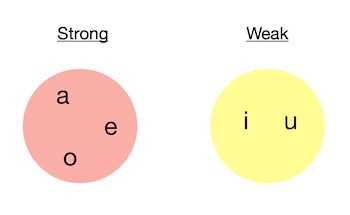Welcome 😊 to our grammar lesson about Spanish accent marks (also called “tildes”).
In Spanish, only vowels can have accent marks. When they do, they look like this:
á, é, í, ó, ú
Or, if they are capitalized:
Á, É, Í, Ó, Ú
In this lesson, we will learn the rules to decide, after hearing a word, whether we should write it with an accent mark.
Then we will practice with some examples and exercises.
Note: The rules we will learn don’t apply to question words such as “qué”, “dónde”, etc. They also don’t apply to monosyllables (one syllable words). At the end of the lesson, we have included two sections about those types of words.
Contents
Introduction: strong and weak vowels
There are two types of vowels in Spanish: strong and weak. This is important for accent marks, as we will see.
Strong vowels are a, e, o and weak vowels are i, u.

Rules for accent marks
In order to know whether a word we hear needs an accent mark, we follow 3 steps. Don’t worry if you don’t understand everything at first, we will see examples soon.
Step 1 – Number the syllables
We number the syllables from right to left.
Numbering syllables can get tricky when two vowels appear together (or with just an “h” between them). The following box explains what to do in that case:
If both vowels are weak, then they belong to the same syllable.
If both are strong, then they belong to different syllables.
If one is weak and the other is strong, we need to consider the following:
- If the stress of the whole word falls on the weak vowel, then they belong to different syllables and, more importantly… the weak vowel needs an accent mark. So we can write the accent mark and SKIP THE REST OF THE PROCESS! 😊
- Otherwise, they belong to the same syllable.
Step 2 – Identify the stressed vowel
Hear the word again. Try to identify the vowel that sounds stressed, and the syllable it belongs to.
Step 3 – Apply the proper rule and decide
We need to apply a different rule depending on the position of the stressed vowel:
If the stressed vowel is in syllable 1…
… then that vowel needs an accent mark only if the word ends in “n”, “s”, or vowel.
If the stressed vowel is in syllable 2…
… then that vowel needs an accent mark only if the word ends in a letter that is NOT “n”, “s” or vowel.
If the stressed vowel is in syllable 3 or higher…
… then that vowel always needs an accent mark.
Examples
Let’s practice with the following 6 words. Some are written correctly, but others need an accent mark:
- arroz, Fernandez, mesa, vivia, despues, simpatico
We will hear each word and follow the steps to decide whether it needs an accent mark:
arroz
Step 1: Number the syllables
a rroz
2 1
Step 2: Identify the stressed vowel
We hear the word and notice the stress is on the “o” in syllable 1.
Step 3: Apply the proper rule and decide
- We apply the rule for words stressed on syllable 1.
- The word ends in “z”.
- So no accent mark.
Solution: arroz
Fernandez
Step 1: Number the syllables
Fer nan dez
3 2 1
Step 2: Identify the stressed vowel
We hear the word and notice the stress is on the “a” in syllable 2.
Step 3: Apply the proper rule and decide
- We apply the rule for words stressed on syllable 2.
- The word ends in “z”.
- So we need an accent mark on the stressed vowel.
Solution: Fernández
mesa
Step 1: Number the syllables
me sa
2 1
Step 2: Identify the the stressed vowel
We hear the word and notice the stress is on the “e” in syllable 2.
Step 3: Apply the proper rule and decide
- We apply the rule for words stressed on syllable 2.
- The word ends in a vowel.
- So no accent mark.
Solution: mesa
vivia
Step 1: Number the syllables
- There are two vowels together, so we need to think:
- One vowel is weak, the other is strong.
- We hear the word, and notice the stress of the whole word falls on the weak vowel “i”.
- So we need an accent mark on the “i”, and we can skip the rest of the process.
Solution: vivía
despues
Step 1: Number the syllables
- There are two vowels together, so we need to think:
- One vowel is weak, the other is strong.
- We hear the word, and notice the stress of the whole word does not fall on the weak “u”.
- That means “pues” is just one syllable.
- We can now confidently number the syllables:
des pues
2 1
Step 2: Identify the the stressed vowel
The stress falls on the “e” in syllable 1.
Step 3: Apply the proper rule and decide
- We apply the rule for words stressed on syllable 1.
- The word ends in “s”.
- So we need an accent mark on the stressed vowel.
Solution: después
simpatico
Step 1: Number the syllables
sim pa ti co
4 3 2 1
Step 2: Identify the the stressed vowel
We hear the word and notice the stress is on the “a” in syllable 3.
Step 3: Apply the proper rule and decide
We apply the rule for words stressed on syllable 3: they always need an accent mark on the stressed vowel.
Solution: simpático
Practice
Quiz
Take this short Quiz to practice accent marks:
Exercise
A few more words! Try to decide if the following words should have an accent mark. (We have highlighted the vowel that sounds stressed). Then check the solutions below.
detras
sorpresa
triangulo
serpiente
magnifico
lio
reo
traidor
Israel
ahinco
comi
habil
reunion
angel
Dario
salud
Solutions
detrás
sorpresa
triángulo
serpiente
magnífico
lío
reo
traidor
Israel
ahínco
comí
hábil
reunión
ángel
Darío
salud
Accents on question words
Question words such as “¿qué?” or “¿dónde?” have an accent mark when they play an interrogative role. The rules learned above don’t apply here.
Here is the list of question words:
- dónde (where)
- adónde (to where)
- cómo (how)
- cuál (which one)
- cuáles (which ones)
- cuándo (when)
- cuánto/a/s (how much, how many)
- qué (what)
- quién (who, singular)
- quiénes (who, plural)
Let’s take “dónde” and “qué” as examples, and read some sentences where they have an accent mark and some sentences where they don’t:
dónde:
¿Dónde estás?
Where are you? (interrogative role)No sé dónde tengo mis gafas.
I don’t know where I have my glasses. (although there are no question marks, the role is interrogative, because someone is wondering where the glasses are)Este es el lugar donde pongo mis gafas.
This is the place where I put my glasses. (no interrogative role)
qué:
¿Qué quieres?
What do you want? (interrogative role)Ellos me preguntan qué quiero.
They ask me what I want. (although there are no question marks, the role is interrogative)Esta es la casa que he comprado.
This is the house that I’ve bought. (no interrogative role)
Accents on monosyllables
In general, monosyllables (one-syllable words) don’t have accent marks.
However, there are a few exceptions. Some monosyllables have several different meanings, and they need an accent mark only when they have a particular meaning.
Here’s the list of monosyllables affected by this, and their meanings with and without accent marks:
| With accent mark | Without accent mark | ||
|---|---|---|---|
| dé | from the verb "dar" | de | of |
| él | he | el | the |
| más | more | mas | but |
| mí | me | mi | my |
| sé | from the verb "ser" or "saber" | se | personal pronoun |
| sí | yes / himself / herself | si | if |
| té | tea | te | personal pronoun |
| tú | you | tu | your |









